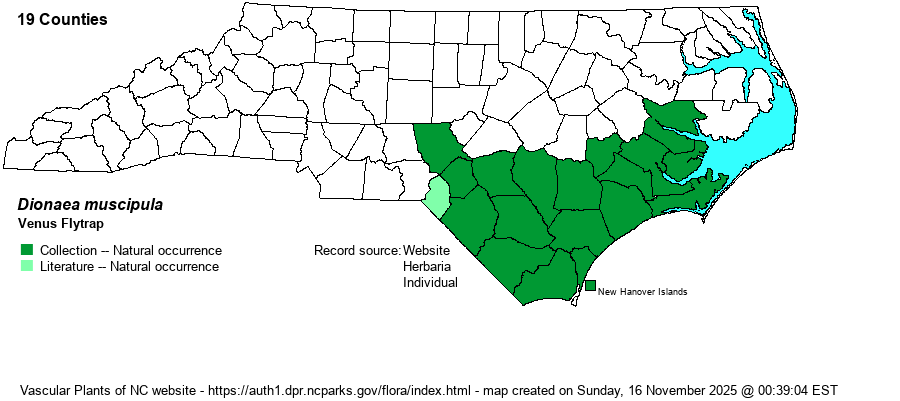| Author | Ellis | |
| Distribution | This species, which needs little or no introduction to people in NC, is found throughout the southern half of the Coastal Plain, but barely ranges into the Sandhills region. It ranges north to southern Beaufort County and formerly to Moore County, for a total of 18 counties. However, the NC NHP database considers the species to be extant now in 15 of them (historical in Moore, Lenoir, and Robeson counties). In 2023, several photos of the species were taken by Jeff Beane in Sandhills Game Land in Scotland County, the plant(s) was apparently transplanted there from an unknown source population.
As should be well known, this unique species is restricted just to southeastern NC and adjacent SC (only in Horry, Georgetown, and Charleston counties), and the well-known phrase "grows only within a 75-mile radius of Wilmington" is often cited but incorrect: populations on Fort Bragg are greater than 100 miles from Wilmington. | |
| Abundance | In well-managed natural areas in the coastal counties from southern Craven and Carteret south to Brunswick, it is still locally common, but away from protected sites it has greatly declined, and is rare in most areas. It has always been very rare as far west as Cumberland, Hoke, and Moore counties, where several small populations still remain in the Sandhills on Fort Bragg. Poaching is still a problem, even though it is now considered a felony if convicted. Thus, in summary now, it is clearly declining, owing more to fire suppression and to conversion of its habitats to pine plantations and development than to poaching, though poaching will always remain an issue. Not surprisingly, the species has been State listed for many years, though it was only listed as State Special Concern and not a higher level, for many years. In May 2021, its status was legally upgraded to State Threatened. | |
| Habitat | This is a wet to perennially moist soil species, found primarily in the wetter portions of pine savannas, as well as in seepages. Many savannas are slightly too dry for it, but scrapes (such as shallow borrow areas) and shallow ditches within or adjacent to savannas can host the species. A few powerline clearings also contain flytraps, though these are, or were, very close to savannas that contain flytraps. As this species exists mainly as several leaves ("traps") close to the ground, the plants can easily be overtopped by taller herbaceous species and certainly by woody species. Thus, most sites need prescribed burns every few years for it to survive. Plants in open scrapes and borrow pits can survive for longer periods without fire. |
| Phenology | Blooms mainly from mid-May to mid-June. Fruits about a month after flowering, in June and July. | |
| Identification | This species is so well-known to Carolinians that it needs little description. Each plant has a rosette of a handful of leaves, each leaf 1-2 inches long, with the outer half being greatly expanded into dime-sized folded "traps", with a hinge down the middle, hairs along the margins, and triggering hairs on the inside. When an insect or spider crawls across the inside of a leaf and hits a triggering hair, the trap quickly closes and traps the bug, for nourishment. The inside of each trap is a dull red color, and it is this reddish color -- if the traps are open -- that allows an observer to better spot a plant in the dense "grassy" vegetation where it grows. Most leaves lie flat on the ground, but some vigorous plants can have more ascending leaves, angled well off the ground. It is in May and June when the species really "shines", as a plant sends up a naked flowering stem about 6-10 inches high, with several fairly large, white, 5-petaled flowers, each about 1-inch across. On the other hand, it is these flowers that bring it to the attention of poachers, as poaching activity peaks during flowering time. After flowering, the stem contains several rounded blackish capsules, each about 1/5-inch across. Careful observers can often detect flytraps in midsummer by these capsules. However, the species is not evergreen, and thus searching for it should be -- best almost on hands and knees! -- from March or April into the fall season. | |
| Taxonomic Comments | Not surprisingly, this species is placed in its own genus. Until fairly recently, Dionaea was also in its own family -- Dionaeaceae. However, recent evidence suggests more closeness to the sundews (Drosera), and it is now included with them in the Family Droseraceae, though it is best not to consider Venus Flytrap as just a glorified sundew!
| |
| Other Common Name(s) | Meadow Clams. The species has often been called, more so in the past, as Venus' Flytrap or Venus' Flytraps. Most references simply shorten the name to make it easier to write and pronounce -- Venus Flytrap. | |
| State Rank | S2 | |
| Global Rank | G2G3 | |
| State Status | T | |
| US Status | | |
| USACE-agcp | FACW link |
| USACE-emp | FACW link |

